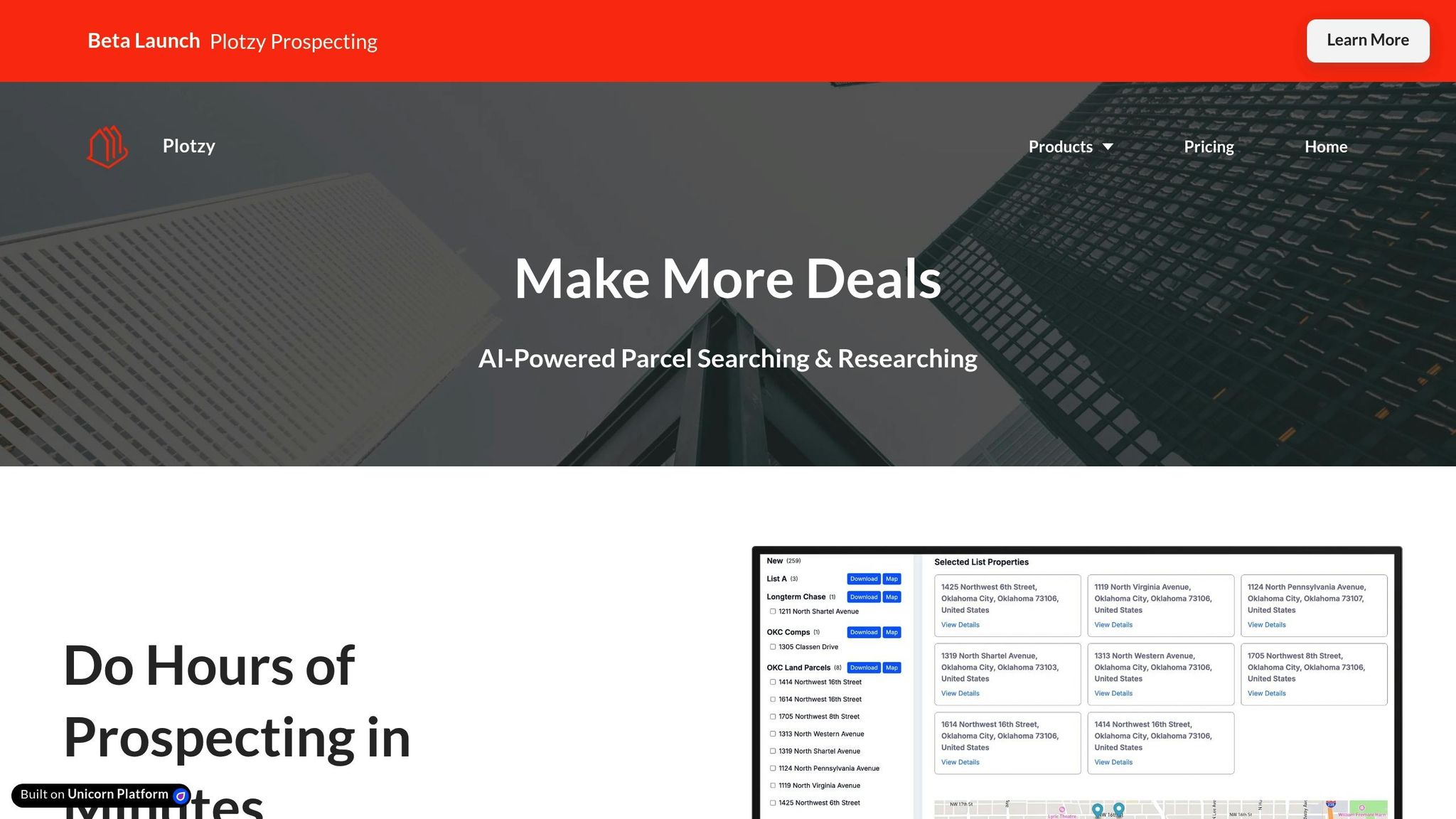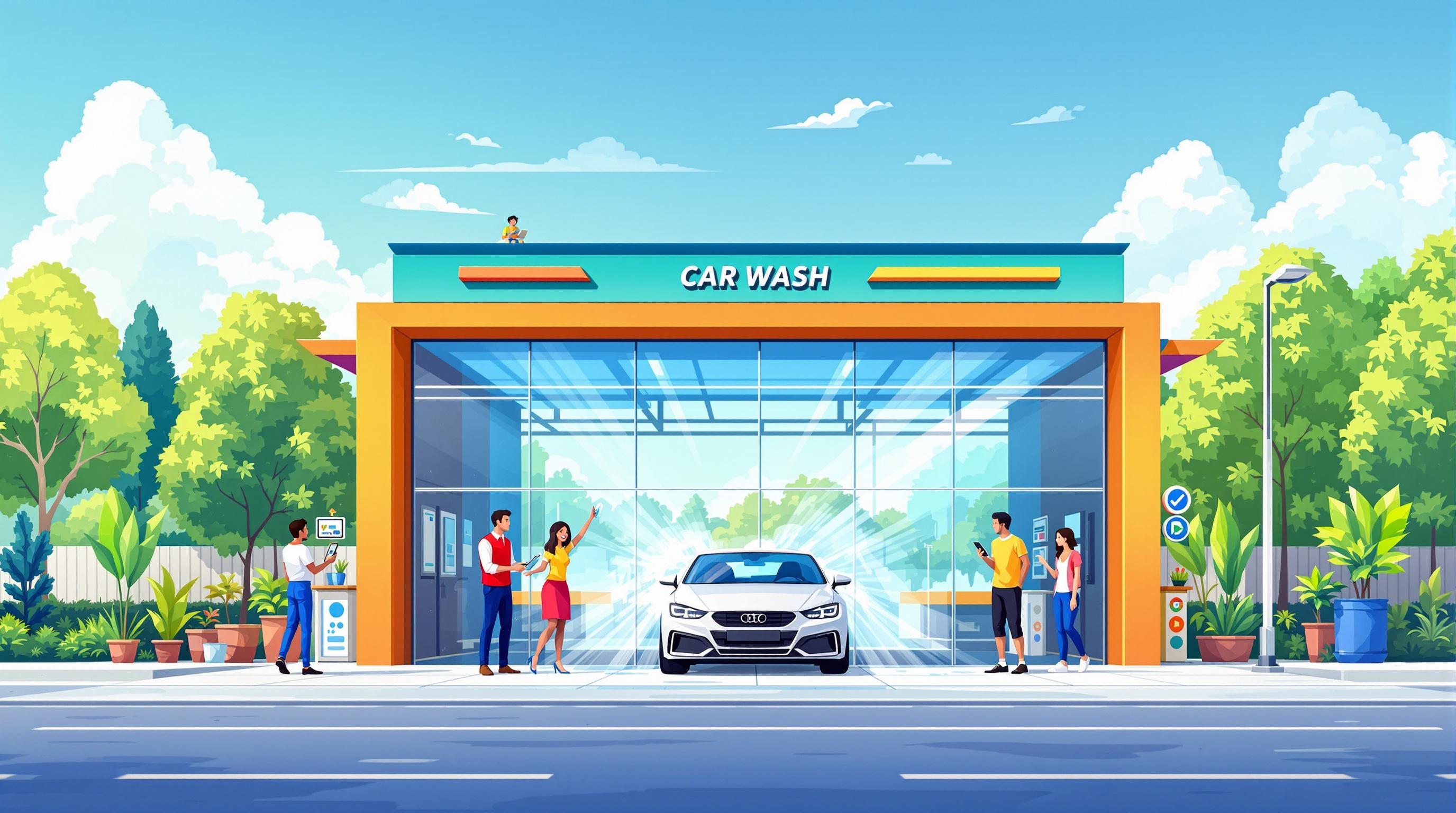Conditional Use Permits (CUPs) allow businesses like gas stations, car washes, and auto dealerships to operate in areas that don’t fully align with zoning rules. These permits ensure compatibility with community standards while addressing potential impacts like traffic, noise, and environmental concerns.
Key Points:
- What is a CUP? A permit for specific uses that don’t conform to zoning but meet strict conditions.
- Why is it needed? To protect communities, avoid full rezoning, and maintain public welfare.
- Application process: Research, prepare site plans and studies, engage with the community, and submit to the planning department. Approval takes 3–9 months and costs $10,000–$20,000.
- Business-specific requirements:
- Gas stations: Spill prevention, environmental assessments, safety plans.
- Car washes: Traffic analysis, noise reduction, water management.
- Auto dealerships: Traffic studies, site plans, landscaping.
Tools to Simplify the Process:
- AI tools like Plotzy streamline zoning research, automate documentation, and help with compliance checks, saving time and reducing errors.
Bottom line: CUPs are essential for businesses in non-standard zones. Proper preparation, community engagement, and digital tools can improve approval chances.
Zoning Laws & Conditional Use Permits for Commercial Real ...
Conditional Use Basics
In commercial real estate - like gas stations, car washes, and auto dealerships - Conditional Use Permits (CUPs) help ensure that specific uses align with local regulations and community standards.
When CUPs Are Required
Property owners need a CUP when they plan to use a site in a way that doesn’t match its current zoning. Some common examples include:
- Gas stations in areas zoned for non-commercial or mixed-use purposes
- Drive-thru restaurants near residential neighborhoods
- Auto dealerships expanding into zones not designated for commercial use
- Any business activity in areas not explicitly zoned for commerce
After an application is submitted, the local planning department reviews it against specific criteria.
Standard CUP Requirements
Planning departments evaluate CUP applications based on several important factors:
- Adequate Site Size: The property must be large enough to handle the proposed use.
- Mitigation Plans: Applicants need to address possible issues like traffic, parking, operating hours, signage, and other community concerns.
- Design Alignment: The project should match the area's aesthetics and fit within existing development patterns.
- Plan Consistency: The proposed use must align with the community's larger development goals.
"Generally speaking, a Conditional Use Permit is required for particular uses and usually contains special conditions to ensure compatibility with surrounding land uses."
CUPs vs. Other Zoning Changes
A CUP allows for a specific exception under set conditions without permanently changing the zoning. In contrast, rezoning modifies the zoning classification entirely. Meanwhile, a variance provides relief from certain zoning rules - usually due to a hardship - whereas a CUP permits a different type of land use under strict conditions.
The CUP process usually takes three to nine months to complete. While a variance adjusts physical requirements, a CUP changes what activities are allowed on the property under specific conditions.
How to Apply for a CUP
Now that we've covered the basics of zoning, here's how you can secure a Conditional Use Permit (CUP).
Application Steps
-
Start with Research and Consultation
Reach out to your local zoning supervisor for advice on requirements and potential challenges. -
Prepare Your Application
Gather detailed site plans, traffic studies, and any necessary impact assessments. Be prepared to budget between $10,000 and $20,000 for fees. -
Engage with the Community
Talk to your neighbors and local officials ahead of the hearing to address any concerns they might have.
Once your application is submitted, the planning commission will review it based on specific approval criteria.
Approval Requirements
The planning commission looks at several factors, including parking availability, site access, landscaping, and how well the project fits with the surrounding area. They also check if your application and technical reports are complete.
After CUP Approval
If the planning commission recommends approval, the city council will make the final decision. You'll also have the right to appeal under local regulations.
sbb-itb-11d231f
CUPs for Specific Businesses
Expanding on the standard CUP requirements detailed in Section 2, these subsections focus on specific conditions for key commercial operations.
Gas Station CUPs
Gas stations must meet strict guidelines, including underground storage tank regulations to prevent soil and groundwater contamination, as well as fire-code and safety standards for handling and storing fuel. Local authorities also require proof of proper commercial zoning and evidence that the station will have minimal impact on nearby properties.
To improve your gas station CUP application:
- Conduct a Phase I Environmental Site Assessment (ESA)
- Install spill prevention and leak detection systems
- Develop an emergency response plan
- Engage with local stakeholders
Meeting these requirements demonstrates your commitment to safety and community standards.
Car Wash CUPs
Car washes must address potential issues related to traffic, noise, and environmental concerns.
Key considerations include:
- Evaluating vehicle queuing capacity
- Conducting a traffic impact analysis
- Implementing noise-reduction measures
- Managing water usage and runoff
- Setting clear hours of operation and maintenance plans
These conditions ensure the car wash site is suitable, operations are well-managed, and it remains compatible with nearby properties.
Auto Dealership CUPs
Auto dealerships typically require large sites and can significantly affect traffic patterns, making detailed site and impact analyses a priority.
A strong dealership CUP application should include:
- A detailed site plan showing display areas, customer parking, and service bays
- Comprehensive traffic studies
- Mitigation strategies for potential impacts
- Clear operational procedures and landscaping plans
Addressing these factors ensures your dealership aligns with local regulations and community expectations.
CUP Research Tools
Once you've outlined the steps for Conditional Use Permits (CUPs), digital tools can help simplify research and ensure compliance.
Digital CUP Research Methods
Digital platforms make it easier to access CUP-related data while minimizing manual work and potential errors. Key features include:
- Property records: Access ownership history and parcel details.
- Zoning resources: Explore interactive maps and review local code sections.
- Document organization: Keep site plans, traffic studies, and environmental reports in one place.
- Code lookup tools: Search municipal ordinances and overlay district requirements.
These tools provide a foundation for integrating AI-driven solutions.
AI for CUP Applications
AI tools can analyze datasets and identify compliance issues early in the process. Some of the benefits include:
- Automating documentation: Create application templates and reports automatically.
- Risk assessment: Detect potential code conflicts or missing studies before submission.
Platforms like Plotzy take these AI capabilities further by offering tailored zoning insights and instant access to property owner data.
Using Plotzy for CUPs

Plotzy is an AI-powered platform designed to simplify the CUP process, which can otherwise take 3 to 9 months and cost between $10,000 and $20,000 in submittal fees.
Here’s how Plotzy helps with CUP applications:
- Instant Zoning Analysis: Quickly identify permitted uses and any restrictions.
- Parcel Filtering: Refine property searches based on specific conditional use criteria.
- Owner Contact Database: Instantly access property owner information.
- Custom Property Reports: Generate detailed reports with zoning and parcel data.
For teams managing multiple or complex applications, Plotzy’s Pro plan offers advanced features like unlimited property and owner searches, enhanced parcel filtering by permitted use, and priority support. This ensures thorough due diligence and efficient tracking.
How Plotzy Optimizes the Process
Plotzy streamlines key steps in the CUP workflow:
- Initial Research: Automate property data collection and zoning checks.
- Documentation: Organize site, traffic, and environmental files in one central location.
- Impact Analysis: Simplify traffic and environmental documentation.
- Application Review: Track progress and receive status updates.
Conclusion
Conditional Use Permits (CUPs) allow gas stations, car washes, and auto dealerships to operate in areas outside standard zoning regulations. The review process typically takes 3–9 months, with fees ranging from $10,000 to $20,000. To improve your chances of approval, ensure your application aligns with local plans and zoning codes, and include site plans, traffic studies, and community-focused benefits like noise and traffic reduction.
- Check local requirements: Contact your local planning department to confirm CUP requirements and review applicable zoning codes.
- Leverage tools like Plotzy: Use Plotzy's AI features for parcel searches, permitted-use filters, owner contact details, and instant zoning reports.
- Prepare thoroughly: Compile site plans, traffic and environmental studies, and other necessary documents. Use tools like Plotzy to monitor building permit and occupancy deadlines.


